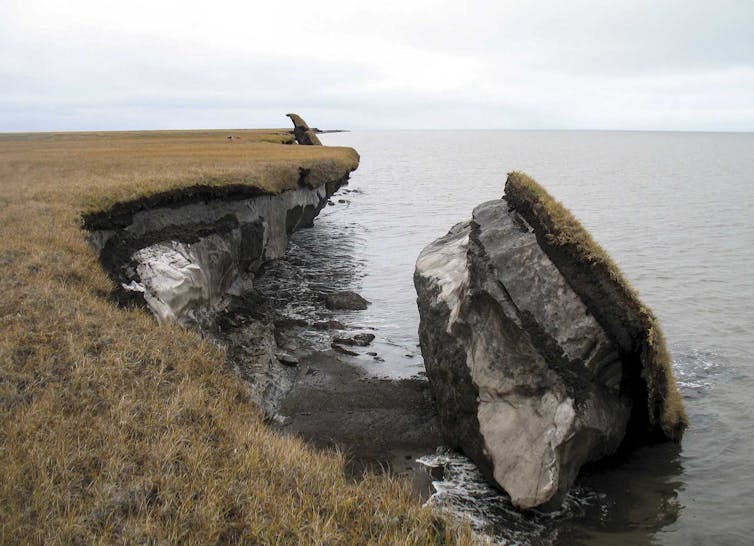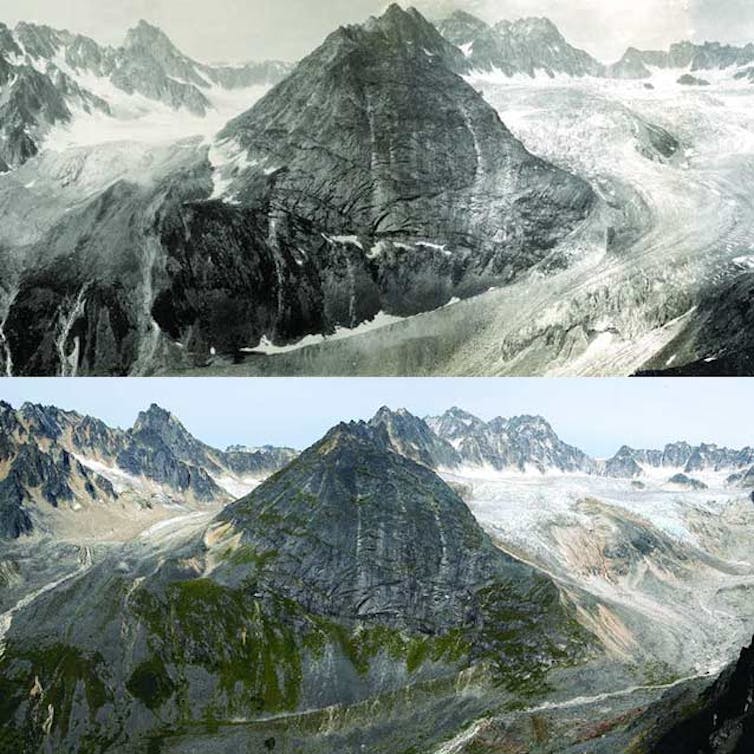Melting Arctic sends a message: Climate change is here in a big way
Posted on 30 May 2018 by Guest Author
Mark Serreze, Research Professor of Geography and director, National Snow and Ice Data Center, University of Colorado
This article was originally published on The Conversation. Read the original article.
Scientists have known for a long time that as climate change started to heat up the Earth, its effects would be most pronounced in the Arctic. This has many reasons, but climate feedbacks are key. As the Arctic warms, snow and ice melt, and the surface absorbs more of the sun’s energy instead of reflecting it back into space. This makes it even warmer, which causes more melting, and so on.
This expectation has become a reality that I describe in my new book “Brave New Arctic.” It’s a visually compelling story: The effects of warming are evident in shrinking ice caps and glaciers and in Alaskan roads buckling as permafrost beneath them thaws.
But for many people the Arctic seems like a faraway place, and stories of what is happening there seem irrelevant to their lives. It can also be hard to accept that the globe is warming up while you are shoveling out from the latest snowstorm.
Since I have spent more than 35 years studying snow, ice and cold places, people often are surprised when I tell them I once was skeptical that human activities were playing a role in climate change. My book traces my own career as a climate scientist and the evolving views of many scientists I have worked with. When I first started working in the Arctic, scientists understood it as a region defined by its snow and ice, with a varying but generally constant climate. In the 1990s, we realized that it was changing, but it took us years to figure out why. Now scientists are trying to understand what the Arctic’s ongoing transformation means for the rest of the planet, and whether the Arctic of old will ever be seen again.
Arctic sea ice has not only been shrinking in surface area in recent years – it’s becoming younger and thinner as well.
Evidence piles up
Evidence that the Arctic is warming rapidly extends far beyond shrinking ice caps and buckling roads. It also includes a melting Greenland ice sheet; a rapid decline in the extent of the Arctic’s floating sea ice cover in summer; warming and thawing of permafrost; shrubs taking over areas of tundra that formerly were dominated by sedges, grasses, mosses and lichens; and a rise in temperature twice as large as that for the globe as a whole. This outsized warming even has a name: Arctic amplification.
The Arctic began to stir in the early 1990s. The first signs of change were a slight warming of the ocean and an apparent decline in sea ice. By the end of the decade, it was abundantly clear that something was afoot. But to me, it looked like natural climate variability. As I saw it, shifts in wind patterns could explain a lot of the warming, as well as loss of sea ice. There didn’t seem to be much need to invoke the specter of rising greenhouse gas levels.
 Collapsed block of ice-rich permafrost along Drew Point, Alaska, at the edge of the Beaufort Sea. Coastal bluffs in this region can erode 20 meters a year (around 65 feet). USGS
Collapsed block of ice-rich permafrost along Drew Point, Alaska, at the edge of the Beaufort Sea. Coastal bluffs in this region can erode 20 meters a year (around 65 feet). USGS
In 2000 I teamed up with a number of leading researchers in different fields of Arctic science to undertake a comprehensive analysis of all evidence of change that we had seen and how to interpret it. We concluded that while some changes, such as loss of sea ice, were consistent with what climate models were predicting, others were not.
To be clear, we were not asking whether the impacts of rising greenhouse gas concentrations would appear first in the Arctic, as we expected. The science supporting this projection was solid. The issue was whether those impacts had yet emerged. Eventually they did – and in a big way. Sometime around 2003, I accepted the overwhelming evidence of human-induced warming, and started warning the public about what the Arctic was telling us.
Seeing is believing
Climate change really hit home for me when when I found out that two little ice caps in the Canadian Arctic I had studied back in 1982 and 1983 as a young graduate student had essentially disappeared.
Bruce Raup, a colleague at the National Snow and Ice Data Center, has been using high-resolution satellite data to map all of the world’s glaciers and ice caps. It’s a moving target, because most of them are melting and shrinking – which contributes to sea level rise.
One day in 2016, as I walked past Bruce’s office and saw him hunched over his computer monitor, I asked if we could check out those two ice caps. When I worked on them in the early 1980s, the larger one was perhaps a mile and a half across. Over the course of two summers of field work, I had gotten to know pretty much every square inch of them.
When Bruce found the ice caps and zoomed in, we were aghast to see that they had shrunk to the size of a few football fields. They are even smaller today - just patches of ice that are sure to disappear in just a few years.
 Hidden Creek Glacier, Alaska, photographed in 1916 and 2004, with noticeable ice loss. S.R. Capps, USGS (top), NPS (bottom)
Hidden Creek Glacier, Alaska, photographed in 1916 and 2004, with noticeable ice loss. S.R. Capps, USGS (top), NPS (bottom)
Today it seems increasingly likely that what is happening in the Arctic will reverberate around the globe. Arctic warming may already be influencing weather patterns in the middle latitudes. Meltdown of the Greenland ice sheet is having an increasing impact on sea level rise. As permafrost thaws, it may start to release carbon dioxide and methane to the atmosphere, further warming the climate.
I often find myself wondering whether the remains of those two little ice caps I studied back in the early 1980s will survive another summer. Scientists are trained to be skeptics, but for those of us who study the Arctic, it is clear that a radical transformation is underway. My two ice caps are just a small part of that story. Indeed, the question is no longer whether the Arctic is warming, but how drastically it will change – and what those changes mean for the planet.































 Arguments
Arguments






























How do we get these kind of stories (and so many others) to the general public? Just read a Discover magazine article on the subject, including reports on hundreds of cracking and destableizing buildings in Siberia, crumbling roads, surfacing of Mammoth bones (people sell the tusks as substitutes for elephant ivory), reemergence of virus spores, etc., etc.
This information needs to be seen on the evening news and in national publications. The Wall Street Journal gave Dr. Singer a megaphone with his easily refutable science on sea level rise. More on the realities of climate change need that kind of coverage.
Study Finds 5,000 May Have Died From Hurricane Maria, Yet Cable News Covered Roseanne Instead
The stories about climate change in Siberia are important, and there are important stories in other countries as well. Our local media don't report them, perhaps because they are unaware, or see them as local issues, but when they are put together they become very important.
It's the sort of thing large media organisations like the Wall Street Journal could investigate as a totality, but the Wall Street journal is biased and writes poor quality articles on climate issues. Here are a collection of reviews of the Wall Street climate change articles, and they are not flattering reviews.
A program I wish every American would watch was a 2-hour presentation on NOVA this spring, titled "Decoding the Weather Machine". From the origins of climate science 200 years ago through to today's science modeling and issues, potential future outcomes and very interesting information on adapting, mitigating and even prospering to avoid the suffering that will come with inaction.
Found it encouraging that one of the Koch brothers, being a principle sponsor of NOVA, would not block this sort of programming. It's available now on Amazon video, for 3 bucks.
Scientists have unearthed remnants that indicate that the Vikings farmed on the Southern tip of Greenland for a few hundred years beginning in the latter part of the 1200's. This is evidence that the Earth has warmed previously as claimed in current climate theory. We appear to be experiencing the same sort of climate change that humans have previously experienced; repeatedly experienced if the climatologists are correct in their theory.
Billev #6, Greenland has been farmed for centuries and still is now.
en.wikipedia.org/wiki/Economy_of_Greenland#Agriculture_and_forestry
"We appear to be experiencing the same sort of climate change that humans have previously experienced;"
Climate change is quite different now. Reconstructions show temperatures over the last decade are higher than during the medieval warm period and in fact higher than the last 10,000 years. The recent warming is driven primarily by greenhouse gases, solar activity has been falling slightly for the last 50 years, and the specific way the earth is heating can only be explained by the greenhouse effect.
I think you know this, and this is why your comments are so lame. You obviously have no real enthusiasm for your own beliefs, and certainly have no evidence to back them up.
While I certainly agree that the media has dropped tha ball in their reporting on Climate Change - I watch a lot of CNN and MSNBC, and it is very seldom even mentioned - one of the main reasons is that they get bombarded by the deniers when they do report anything. Whether or not they are paid trolls - and I gather there is ample avidence that a lot of them are - the media outlets shy away from it just to keep the noise down. So in that way, the disinformation campaign is winning. For now. Of course, when it gets hot enough, the denial will evaporate. Unfortunately, so will everything else...